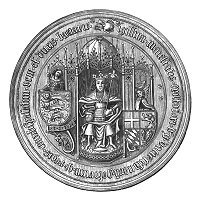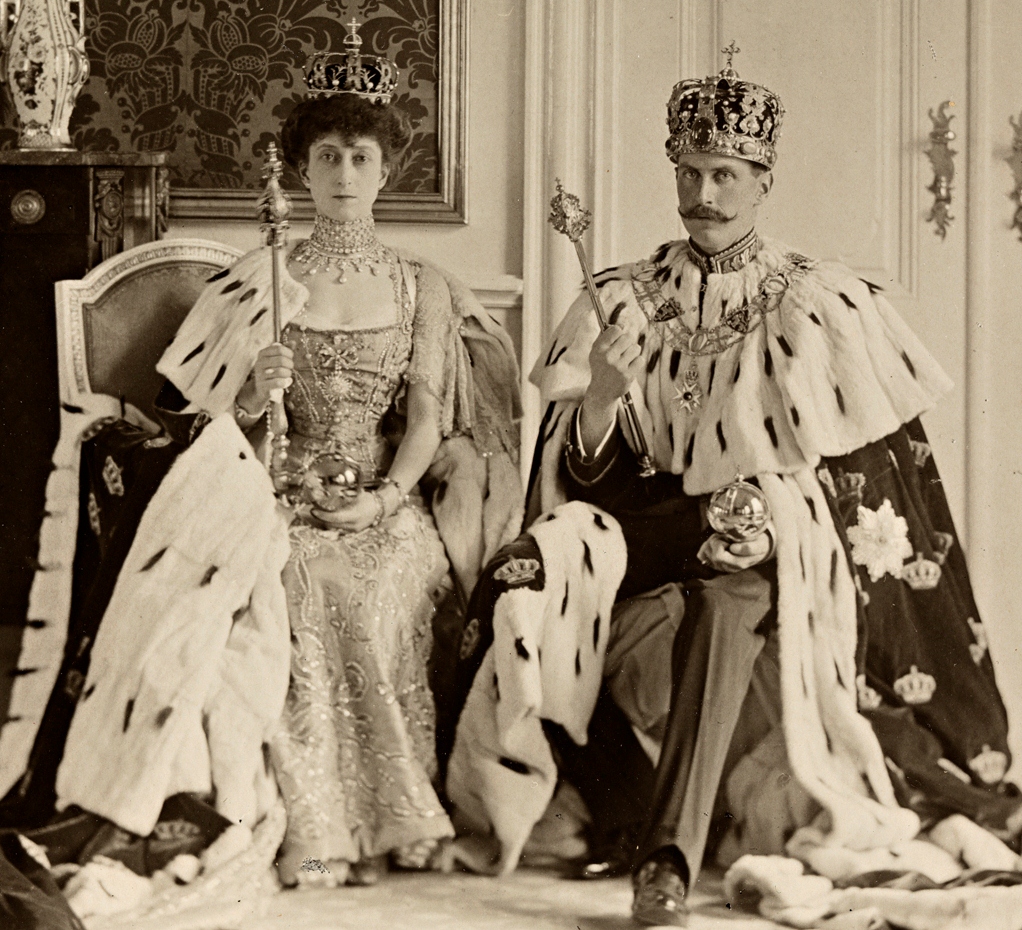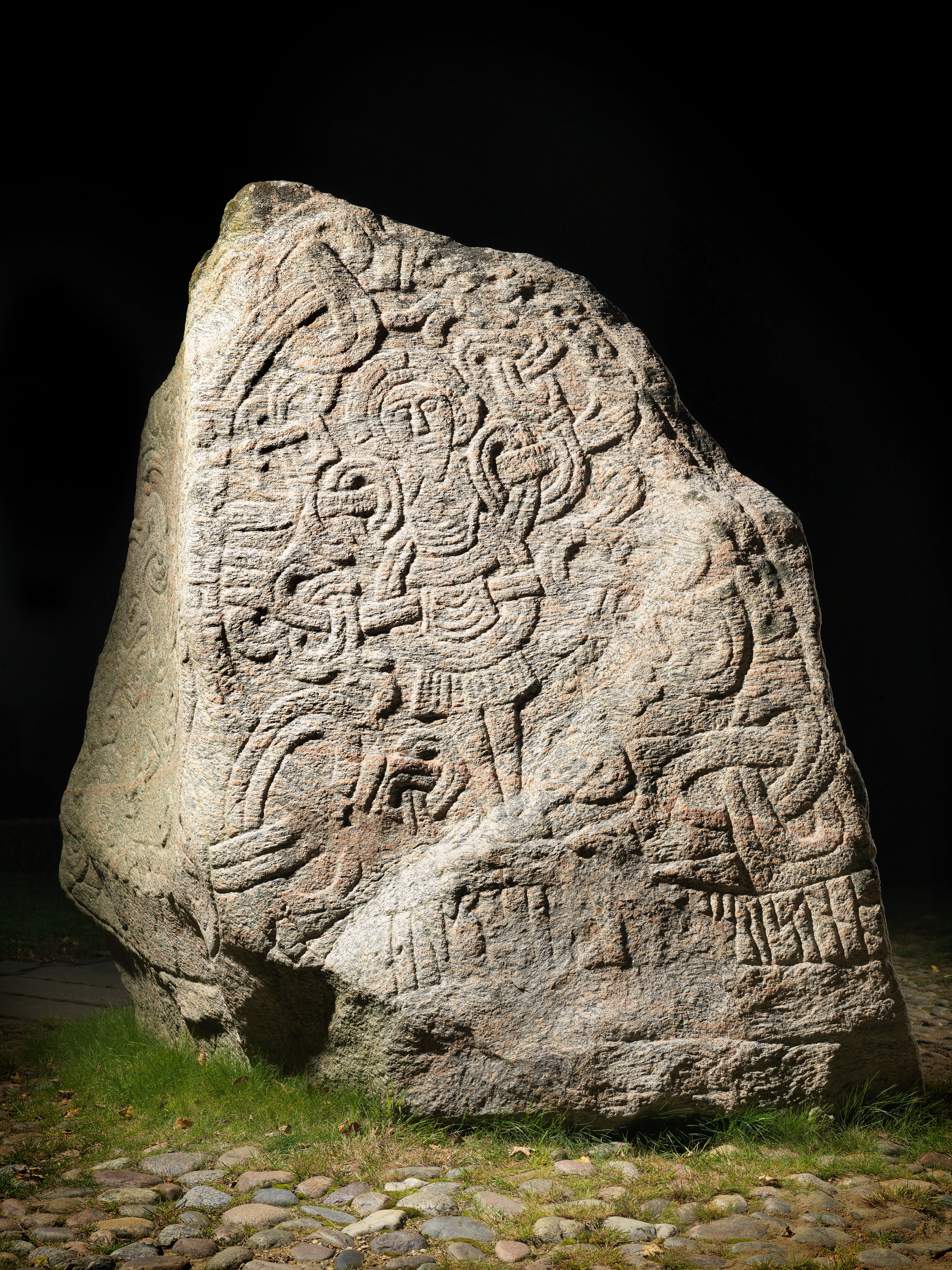|
Christopher III Of Denmark
Christopher of Bavaria (26 February 1416 – 5/6 January 1448) was King of Denmark (1440–48, as Christopher III), Sweden (1441–48) and Norway (1442–48) during the era of the Kalmar Union. Biography Coming to power He was the son of John, Count Palatine of Neumarkt (1383–1443) and Catherine of Pomerania (c. 1390–1426). Catherine was the daughter of Wartislaw VII, Duke of Pomerania in Pomerania-Stolp, and sister of the Scandinavian king, Eric of Pomerania. Count Palatine John was a son of King Rupert of Germany (1352–1410). Christopher was probably born at Neumarkt in der Oberpfalz in Upper Palatinate, in Bavaria, Germany. In 1445, Christopher married Dorothea of Brandenburg (1430 – 25 November 1495) in Copenhagen. Eric of Pomerania was deposed as king of Denmark and Sweden in 1439. Eric's nephew, Christopher, who was rather unfamiliar with Scandinavian conditions, was elected by the Danish State Council as the successor to his uncle, first as regent from 1439, ... [...More Info...] [...Related Items...] OR: [Wikipedia] [Google] [Baidu] |
List Of Danish Monarchs
This is a list of Danish monarchs, that is, the kings and queens regnant of Denmark. This includes: * The Kingdom of Denmark (up to 1397) ** Personal union of Denmark and Norway (1380–1397) * The Kalmar Union (1397–1536) ** Union of Denmark, Norway and Sweden (1397–1523) ** Union of Denmark and Norway (1523–1536/1537) * The United Kingdoms of Denmark–Norway (1536/1537–1814) * The Kingdom of Denmark (1814–present) ** Iceland (since the union between Denmark and Norway in 1380; independent kingdom in a personal union with Denmark 1918–1944; a sovereign republic since 1944) ** Greenland (since the union between Denmark and Norway in 1380; effective Danish–Norwegian control began in 1721; integrated into the Danish realm in 1953; internal home rule introduced 1979; self-determination assumed in 2009; Greenland has two out of 179 seats in the Danish parliament Folketinget) ** Faroe Islands (since the union between Denmark and Norway in 1380; County of Denmark 1816– ... [...More Info...] [...Related Items...] OR: [Wikipedia] [Google] [Baidu] |
Roskilde
Roskilde ( , ) is a city west of Copenhagen on the Danish island of Zealand. With a population of 51,916 (), the city is a business and educational centre for the region and the 10th largest city in Denmark. It is governed by the administrative council of Roskilde Municipality. Roskilde has a long history, dating from the pre-Christian Viking Age. Its UNESCO-listed Gothic cathedral, now housing 39 tombs of the Danish monarchs, was completed in 1275, becoming a focus of religious influence until the Reformation. With the development of the rail network in the 19th century, Roskilde became an important hub for traffic with Copenhagen, and by the end of the century, there were tobacco factories, iron foundries and machine shops. Among the largest private sector employers today are the IT firm BEC (Bankernes EDB Central) and seed company DLF. The Risø research facility is also becoming a major employer, extending interest in sustainable energy to the clean technology sphere. The ... [...More Info...] [...Related Items...] OR: [Wikipedia] [Google] [Baidu] |
Germany
Germany,, officially the Federal Republic of Germany, is a country in Central Europe. It is the second most populous country in Europe after Russia, and the most populous member state of the European Union. Germany is situated between the Baltic and North seas to the north, and the Alps to the south; it covers an area of , with a population of almost 84 million within its 16 constituent states. Germany borders Denmark to the north, Poland and the Czech Republic to the east, Austria and Switzerland to the south, and France, Luxembourg, Belgium, and the Netherlands to the west. The nation's capital and most populous city is Berlin and its financial centre is Frankfurt; the largest urban area is the Ruhr. Various Germanic tribes have inhabited the northern parts of modern Germany since classical antiquity. A region named Germania was documented before AD 100. In 962, the Kingdom of Germany formed the bulk of the Holy Roman Empire. During the 16th ce ... [...More Info...] [...Related Items...] OR: [Wikipedia] [Google] [Baidu] |
Rupert Of Germany
Rupert of the Palatinate (german: Ruprecht von der Pfalz; 5 May 1352 – 18 May 1410), sometimes known as Robert of the Palatinate, a member of the House of Wittelsbach, was Elector Palatine from 1398 (as Rupert III) and King of Germany from 1400 until his death. Early life Rupert was born at Amberg in the Upper Palatinate, the son of Elector Palatine Rupert II and Beatrice of Aragon, daughter of King Peter II of Sicily. Rupert's great-granduncle was the Wittelsbach emperor Louis IV. He was raised at the Dominican Liebenau monastery near Worms, where his widowed grandmother Irmengard of Oettingen lived as a nun. Reign From his early years Rupert took part in the government of the Electoral Palatinate to which he succeeded on his father's death in 1398. He and the three ecclesiastical prince-electors (of Mainz, Cologne and Trier) met at Lahneck Castle in Oberlahnstein on 20 August 1400 and declared their king, Wenceslaus, deposed. On the next day the same four electors met at ... [...More Info...] [...Related Items...] OR: [Wikipedia] [Google] [Baidu] |
Pomerania-Stolp
The Duchy of Pomerania-Stolp, also known as the Duchy of Stolp, and the Duchy of Słupsk, was a feudal duchy in Farther Pomerania within the Holy Roman Empire. Its capital was Słupsk. It was ruled by the Griffin dynasty. It existed in the High Middle Ages era from 1368 to 1478. Background The Duchy of Pomerania was partitioned several times to satisfy the claims of the male members of the ruling House of Pomerania dynasty.Kyra T. Inachin, Die Geschichte Pommerns, Hinstorff Rostock, 2008, p.30, The partitions were named after the ducal residences: Pomerania-Barth, -Demmin, -Rügenwalde, -Stettin, -Stolp, and -Wolgast. None of the partitions had a hereditary character,Norbert Buske, Pommern, Helms Schwerin 1997, p.21, the members of the House of Pomerania inherited the duchy in common. The duchy thus continued to exist as a whole despite its division. Creation: Partition of 1368/72 After the death of Barnim IV of Pomerania-Wolgast in 1366, an armed conflict arose when B ... [...More Info...] [...Related Items...] OR: [Wikipedia] [Google] [Baidu] |
Duke Of Pomerania
This is a list of the duchies and dukes of Pomerania. Dukes of the Slavic Pomeranian tribes (All Pomerania) The lands of Pomerania were firstly ruled by local tribes, who settled in Pomerania around the 10th and 11th centuries. Non-dynastic In 1106, Pomerania is divided by his two older sons: Wartislaw, who founded the House of Pomerania and the Duchy of Pomerania, and Świętopełk I. After Swietopelk's death, his lands were occupied by the Saxon prince Lothar of Supplinburg. In 1155, the lands regained independence under Sobieslaw I, who founded the dynasty of the Samborides, and the Duchy of Pomerelia. Duchy of Pomerania The Duchy resulted from the partition of Świętobor, Duke of Pomerania, in which his son Wartislaw inherited the lands that would become in fact known as ''Pomerania''. Partitions of Pomerania First partition 1155–1264 In 1155, Pomerania was divided in Pomerania-Szczecin and Pomerania-Demmin. In the struggle to shake off Polish and Danish c ... [...More Info...] [...Related Items...] OR: [Wikipedia] [Google] [Baidu] |
Wartislaw VII, Duke Of Pomerania
Wartislaw VII ( pl, Warcisław VII) (1363/1365 – 1394/1395) was one of the Dukes of Pomerania. His full name was Henry Wartislaw.The King Who Became a Pirate Story by Anja Klemp Vilgaard · Illustrations by Darya Malikova · Edited by Shawna Kenney · April 20, 2020, narratively.com. Life He was the son of Bogislaw V, brother of Casimir IV and Bogislaw VIII. He married Maria of Mecklenburg-Schwerin (daughter of Henry III, Duke of Mecklenburg) and was the father of Eric of Pomerania and Catherine of Pomerania. In 1377 he became Duke of Pomerania in Pomerania-Stolp; at times he was its coruler with his brother, Bogislaw VIII. He maneuvered between two local powers, the Teutonic Knights and the Kingdom of Poland. In 1386 he allied himself with the Knights; but in 1390, by the Treaty of Pyzdry, he allied himself with Poland, and pledged vassalage to the king of Poland, Władysław Jagiełło. In return, he received the territory of Nakło from the Polish king. In 139 ... [...More Info...] [...Related Items...] OR: [Wikipedia] [Google] [Baidu] |
Kalmar Union
The Kalmar Union (Danish language, Danish, Norwegian language, Norwegian, and sv, Kalmarunionen; fi, Kalmarin unioni; la, Unio Calmariensis) was a personal union in Scandinavia, agreed at Kalmar in Sweden, that from 1397 to 1523 joined under a single monarch the three kingdoms of Denmark, Sweden (then including most of present-day Finland), and Norway, together with List of possessions of Norway#Former dependencies and homelands, Norway's overseas colonies Norway retained none of its prior possessions, however. Christian I pledged the Northern Isles to Scotland as insurance for his daughter’s dowery in 1468; when the dowery wasn’t paid the islands transferred to perpetual Scottish sovereignty in 1470. Following the Union’s dissolution, all remaining overseas possessions brought into the Union by Norway became property of the Danish monarch; who retained ownership following the transfer of the Kingdom of Norway from the Danish crown to Swedish crown (discussed in further ... [...More Info...] [...Related Items...] OR: [Wikipedia] [Google] [Baidu] |
King Of Norway
The Norwegian monarch is the head of state of Norway, which is a constitutional and hereditary monarchy with a parliamentary system. The Norwegian monarchy can trace its line back to the reign of Harald Fairhair and the previous petty kingdoms which were united to form Norway; it has been in unions with both Sweden and Denmark for long periods. The present monarch is King Harald V, who has reigned since 17 January 1991, succeeding his father, Olav V. The heir apparent is his only son, Crown Prince Haakon. The crown prince undertakes various public ceremonial functions, as does the king's wife, Queen Sonja. The crown prince also acts as regent in the king's absence. There are several other members of the royal family, including the king's daughter, grandchildren and sister. Since the dissolution of the union between Norway and Sweden and the subsequent election of a Danish prince as King Haakon VII in 1905, the reigning royal house of Norway has been a branch of the Schleswig- ... [...More Info...] [...Related Items...] OR: [Wikipedia] [Google] [Baidu] |
King Of Sweden
The monarchy of Sweden is the monarchical head of state of Sweden,See the Instrument of Government, Chapter 1, Article 5. which is a constitutional and hereditary monarchy with a parliamentary system.Parliamentary system: see the Instrument of Government, Chapter 1, Article 1. There have been kings in what now is the Kingdom of Sweden for more than a millennium. Originally an elective monarchy, it became a hereditary monarchy in the 16th century during the reign of Gustav Vasa, though virtually all monarchs before that belonged to a limited and small number of families which are considered to be the royal dynasties of Sweden. Sweden in the present day is a representative democracy in a parliamentary system based on popular sovereignty, as defined in the current Instrument of Government (one of the four Fundamental Laws of the Realm which makes up the written constitution). The monarch and the members of the royal family undertake a variety of official, unofficial and other re ... [...More Info...] [...Related Items...] OR: [Wikipedia] [Google] [Baidu] |
King Of Denmark
The monarchy of Denmark is a constitutional political system, institution and a historic office of the Kingdom of Denmark. The Kingdom includes Denmark proper and the autonomous administrative division, autonomous territories of the Faroe Islands and Greenland. The Kingdom of Denmark was already consolidated in the 8th century, whose rulers are consistently referred to in Franks, Frankish sources (and in some late Frisians, Frisian sources) as "kings" (). Under the rule of King Gudfred in 804 the Kingdom may have included all the major provinces of medieval Denmark. The current unified Kingdom of Denmark was founded or re-united by the Vikings, Viking kings Gorm the Old and Harald Bluetooth in the 10th century. Originally an elective monarchy, it became hereditary monarchy, hereditary only in the 17th century during the reign of Frederick III of Denmark, Frederick III. A decisive transition to a constitutional monarchy occurred in 1849 with the writing of the first democrat ... [...More Info...] [...Related Items...] OR: [Wikipedia] [Google] [Baidu] |
Swedish Language
Swedish ( ) is a North Germanic language spoken predominantly in Sweden and in parts of Finland. It has at least 10 million native speakers, the fourth most spoken Germanic language and the first among any other of its type in the Nordic countries overall. Swedish, like the other Nordic languages, is a descendant of Old Norse, the common language of the Germanic peoples living in Scandinavia during the Viking Era. It is largely mutually intelligible with Norwegian and Danish, although the degree of mutual intelligibility is largely dependent on the dialect and accent of the speaker. Written Norwegian and Danish are usually more easily understood by Swedish speakers than the spoken languages, due to the differences in tone, accent, and intonation. Standard Swedish, spoken by most Swedes, is the national language that evolved from the Central Swedish dialects in the 19th century and was well established by the beginning of the 20th century. While distinct regional varieties ... [...More Info...] [...Related Items...] OR: [Wikipedia] [Google] [Baidu] |






